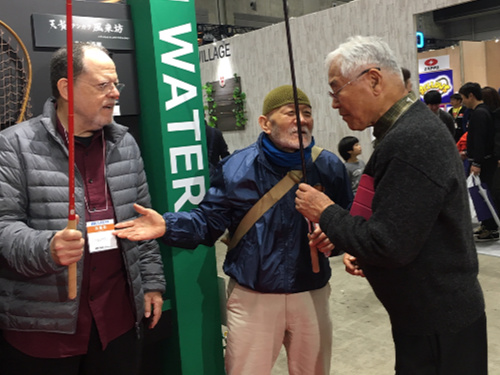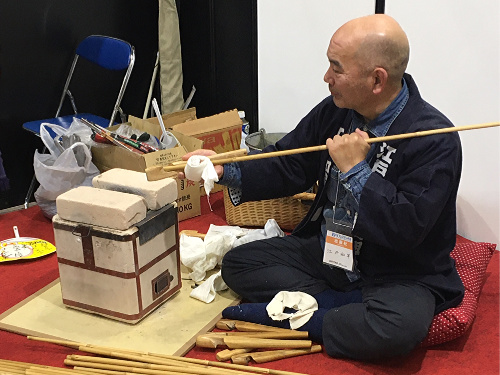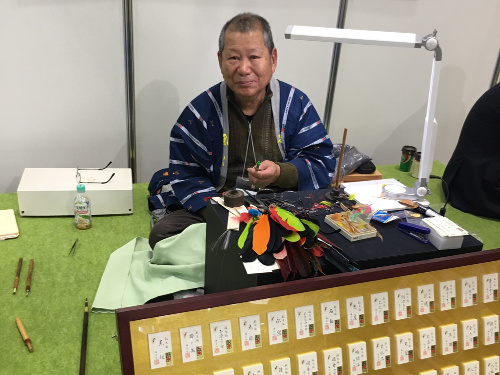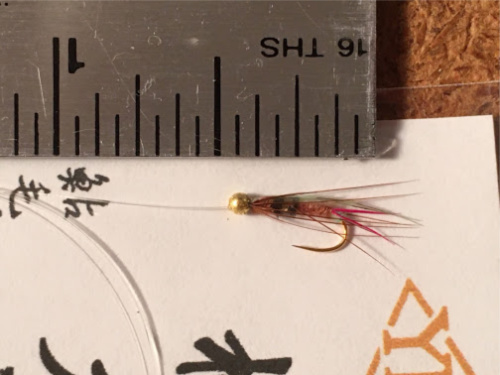Yokohama Fishing Show 2020
On January 17 and 18 I attended the Yokohama Fishing Show as a guest of Tenryu. My primary goal for the show was to visit with Tenryu Chairman Miyoshi Shiozawa, Fishing Tackle Division Manager Takuya Shiozawa and product development and sales personnel to discuss their new Rayz and Rayz Spectra spinning and baitcasting rods.
 At the Yokohama Fishing Show with Sebata san (center) and
At the Yokohama Fishing Show with Sebata san (center) and Chairman Shiozawa (right).
However, I did get to meet Sebata san, who is rightfully a legend among tenkara anglers, and to see Dr. Ishigaki, who was at the show to give a tenkara lecture and casting demonstration. I also met my arch competitor, Keiichi Okushi, who is living proof that competitors can be friends, and with whom I hope to fish on a subsequent trip to Japan (as long as he promises we won't be climbing up any waterfalls, which seems to be central to his genryu fishing).
 Yasuo Nakadai straightening bamboo.
Yasuo Nakadai straightening bamboo.At the show, I also met Yasuo Nakadai, a maker of Edo Wazao - the traditional Japanese bamboo rods. He started as an apprentice at the age of 17 and has been making bamboo rods for 40 years now. At the show, he was demonstrating how bamboo is straightened by heating it between two bricks on a small furnace and then repeatedly bending it a little bit at a time.
He mentioned that he was in a video shot by NHK that would be released a few days after the show. The video, on tanago fishing, showed him shaping the tip section of a tanago rod by shaving it with a tool that looked more like a knife than a plane. Very delicate work.
At the show, he was in a booth with two other Edo Wazao craftsmen. I looked longingly at the tanago rods on display, but since I was not planning to buy one at the time, I didn't ask the price. I also didn't ask which of the craftsmen had made the rods that were on display. I later found out that one of Nakadai san's tanago rods was up on an auction site for 150,000 yen (roughly $1400)!
 Kazutsugu Fujiwara tying Banshu Kebari
Kazutsugu Fujiwara tying Banshu KebariAt another booth I met a Kazutsugu Fujiwara, who was tying Ayu flies
(Banshu Kebari). The vise he was using to hold the very small hook was a
pin vise set into a short bamboo rod. The pin vise holds the hook at
the head, not at the bend like a western fly tying vise. The bamboo rod
was held in his left hand and rotated in his fingers. The thread and
the body material was held in his stationary right hand. The thread and body was wrapped by rotating the hook - just the opposite of how tenkara kebari and western flies are tied. (I have since seen YouTube videos showing tyers holding the rod stationary, and wrapping the thread and body material around the hook.) To me, the hardest part appears to be wrapping the hackle, which consists of just six hackle barbs that extend back past the hook bend, almost parallel to the hook shaft.
 Banshu Kebari for Ayu fishing (about 3/8" long)
Banshu Kebari for Ayu fishing (about 3/8" long)I have seen many images of Banshu Kebari, but none showed them alongside anything that showed their size. They are much smaller than I had expected, probably equivalent to a size 18 nymph hook. They are very delicate flies. In Japan, I believe they are used only for Ayu but I have to think that they would be very effective for trout as well. Fujiwara san very generously gave be a couple of his flies, with which I'll test my theory.
In January, Japanese streams are all closed to fishing, and I didn't have time to stop at any of the Areas (private pay-to-fish lakes that are open in the winter). So, no fishing this trip, but there is so much more to visiting Japan than just fishing. Truth be told, the fishing (or at least the catching), is better here. The culture, the people, the food - they're worth the trip even if you never fish.
TenkaraBum Home > Trip Reports > Yokohama Fishing Show 2020
“The bitterness of poor quality remains long after the sweetness of low price is forgotten” - Benjamin Franklin
"Be sure in casting, that your fly fall first into the water, for if the line fall first, it scares or frightens the fish..." -
Col. Robert Venables 1662
As age slows my pace, I will become more like the heron.
We've all had situations where seriously chewed up flies kept catching fish after fish after fish. It is no sin to tie flies that come off the vise looking seriously chewed up.
Warning:
The hooks are sharp.
The coffee's hot.
The fish are slippery when wet.
Beware of the Dogma
Seriously, all the hooks sold on TenkaraBum.com, whether packaged as loose hooks or incorporated into flies, are dangerously sharp. Some have barbs, which make removal from skin, eyes or clothing difficult. Wear eye protection. Wear a broad-brimmed hat. If you fish with or around children, bend down all hook barbs and make sure the children wear eye protection and broad-brimmed hats. Be aware of your back cast so no one gets hooked.
Also, all the rods sold on TenkaraBum.com will conduct electricity. Do not, under any circumstances, fish during a thunder storm. Consider any fishing rod to be a lightning rod! Fishing rods can and do get hit by lightning!
What's in stock?
Suntech Tenkarakyo 40F Tenkara Rods
Nissin Oni Tenkara Line
Coming Soon
January
Kurenai II AR 30F
Kurenai II AR 33F
Kurenai II AR 39F
TenkaraBum 33
TenkaraBum 36
TenkaraBum 40
Furaibo TF39
Furaibo TF39TA
Latest Pages
If you enjoy spin fishing or baitcasting please visit my sister site Finesse-Fishing.com.


